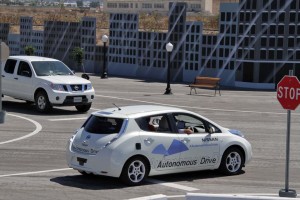
A prototype Nissan Leaf autonomous vehicle negotiates a simulated urban intersection, complete with cross traffic.
Today’s new cars are routinely loaded with an array of advanced technologies, so it wasn’t a complete surprise to see the small ports cut into the front fenders and rear door panels of the little Nissan Leaf, nor the camera mounted behind the rearview mirror. But there was no way to completely prepare for what happened as the vehicle was shifted from conventional to autonomous mode.
With just a brief warning in synthetic speech, the Leaf suddenly came to life, surging ahead as if possessed, heading out onto a course designed to mimic a typical urban route, complete with stop signs, passing lanes – and oncoming traffic.
The extra hardware – and the words, “Autonomous Vehicle” on the side of the car – were, in fact, the giveaway that this was a prototype of the self-driving car Nissan this week promised to put into production by 2020. It is so confident of the role that autonomous vehicles will play in the future that the Japanese automaker’s global product development chief said the technology will quickly roll out across the Nissan line-up.
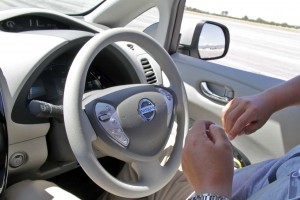
It may take a leap of faith to let go of the wheel today, but future motorists will likely think nothing of it.
“Basically, within a decade, you’ll have this technology available in every car” bearing the Nissan badge, as well as on its high-line Infiniti brand models, explained product czar Andy Palmer during a lunch conversation at a Nissan event in Southern California.
And the second-largest Japanese maker isn’t alone. Once considered the purview of science fiction writers, virtually every major automaker now is working on autonomous technology – and so is Silicon Valley tech giant Google. At a recent industry confab in Detroit, a number of experts suggested the technology could begin rolling into showrooms between 2020 and 2025, though other observers questioned whether the industry could move that fast.
(For more on Nissan’s autonomous vehicle strategy, Click Here.)
According to Nissan’s Palmer and other proponents, autonomous vehicles will offer a number of potential advantages, including reduced traffic congestion, lower fuel consumption and reduced CO2 emissions – though safety is perhaps the most promising payoff.
Using a mix of cameras, radar and sonar sensors, a number of vehicles already are equipped with technology “paving the way towards (fully) autonomous driving,” noted Daimler AG CEO Dieter Zetsche during a recent preview of the new 2014 Mercedes-Benz S-Class. That big sedan can come to a screeching halt if, for example, a child dashes into the street, and it can slow or accelerate to keep pace with traffic ahead. It can take steps to prevent, or at least minimize, the impact in the event another vehicle runs a stop sign.
(New Mercedes S-Class is nearly autonomous. Click Here for the test drive.)
And the autonomous vehicle that Nissan plans to bring to market by the beginning of the next decade will do the same sort of things if the driver chooses to keep hands on wheel, according to those running the project. But the network of sensors and microprocessors also will be able to completely take over driving duties — as we experienced on a pair of test tracks laid out on the old Miramar Air Force base in Orange County.
With the flip of a switch, we went from driver to passenger – or, as project co-director Maarten Sierhuis prefers, “co-pilot.”
(New Volvo technology can drop you off and find a parking spot on its own. Click Here for more.)
With a whir, the Nissan Leaf came to life, the steering wheel making the sort of minor corrections one would normally expect if it were being held in human hands. The battery-electric vehicle handily maneuvered around the figure-eight urban course, slowing to accommodate oncoming traffic as it squeezed around another car parked partially in its lane.
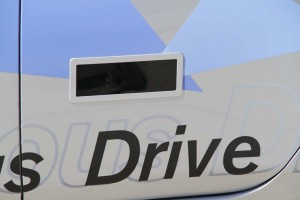
This prototype Nissan Leaf uses laser side scanners, as well as cameras and other sensors to see what's happening on the road around it.
Sweeping around a corner it came to an intersection designed to simulate the typical urban street corner. On its first lap, the vehicle stopped and waited to allow another car to proceed as it had come first into the intersection. Following the sort of rules humans are supposed to learn, the autonomous Leaf was first to drive through at the next intersection.
“We need to be able to drive any intersection anywhere and at any time to be fully autonomous,” stressed the former NASA scientist to explain why Nissan – and its competitors — expects to need the better part of a decade getting things down right.
But on a bright and cloudless afternoon, all seemed to be living up to that challenge. A Nissan Leaf prototype also readily maneuvered through a simulated highway course that included merging traffic and even the ubiquitous orange cones marking out a construction site.
Autonomous technology has already moved from the test track to public roads. Google, for example, claims to have logged tens of thousands of miles of real-world testing so far. Nevada recently became the first state to formally create a special license for autonomous vehicles. California will launch a similar program next year, with other states to follow.
Nissan’s announcement puts pressure on other manufacturers to follow. But it also sounds an alert for lawmakers and regulators, stressed Nissan Executive Vice President Palmer, noting that “The legal framework has to support autonomous driving vehicles.”
What automakers fear is finding plaintiffs’ attorneys perched like vultures waiting for any possible opportunity to blame autonomous vehicles in search of big legal settlements. In fact, the litigious nature of the U.S. could force makers to first launch the technology in other, tech-friendlier markets. But, sooner or later, Palmer says, autonomous technology will make the leap from science fiction to local streets.

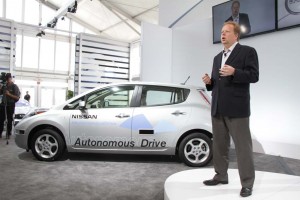
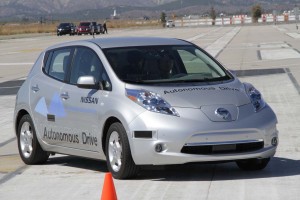
Many wannabe auto “operators” are really just passengers when they decide to play with their electronic toys instead of driving their vehicle properly.